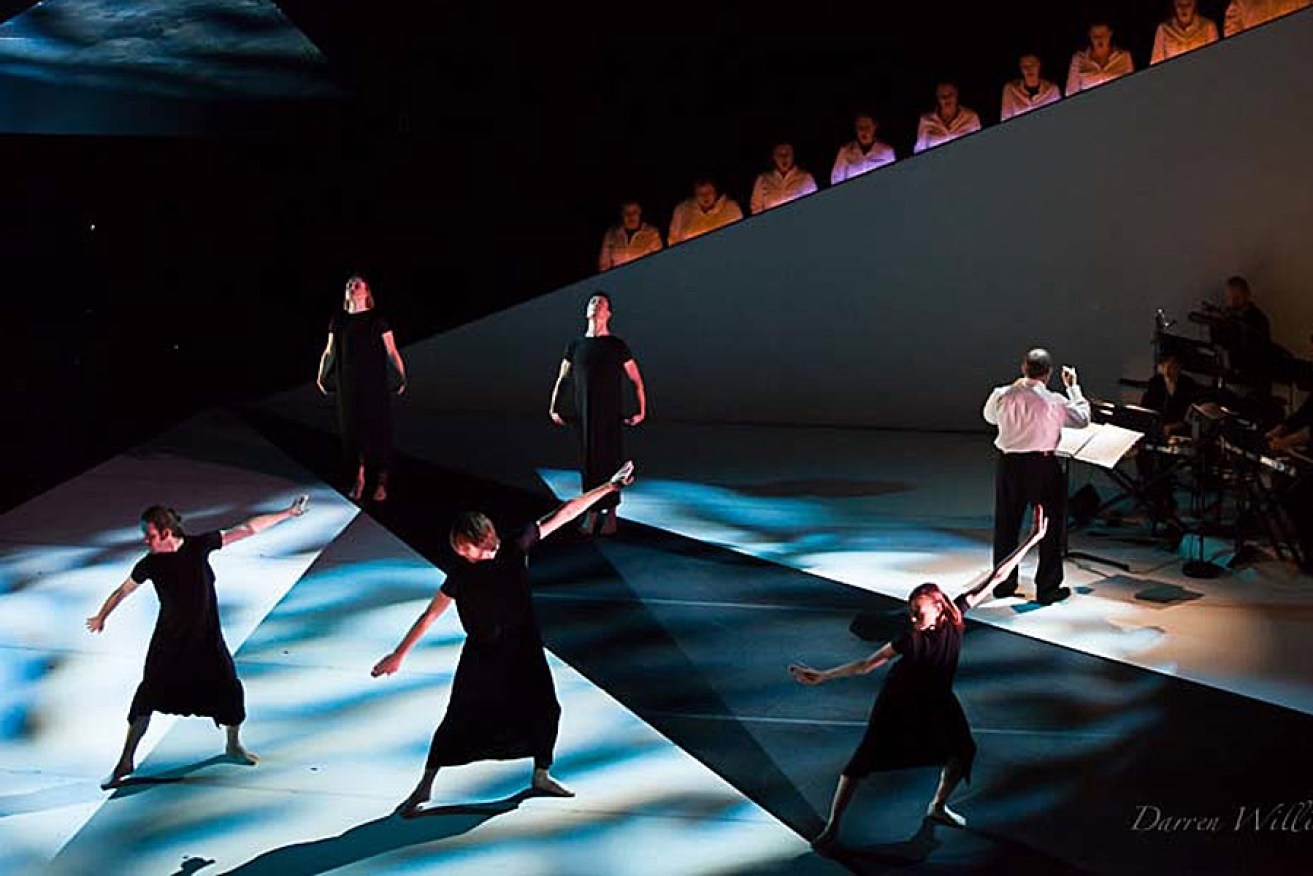Philip Glass Trilogy: Einstein on the Beach

Einstein on the Beach. Photo: Darren Williams Photography
Leigh Warren and Timothy Sexton’s realisation of Philip Glass’s contemporary work Einstein on the Beach is outstanding. The physical demands and artistic challenges required of the singers, dancers, musicians, tech crew and audience are incredible and require super-human efforts.
Apparently, Glass was unsure whether his creation was, technically, an opera, but it doesn’t matter, because Einstein on the Beach is a powerful theatrical experience which – inspired by Einstein’s ability to question, wonder and imagine – is in itself a work of beauty that encourages all who are involved to explore the universe. The opera (the second work in The Philip Glass Trilogy) defies convention and refuses to be neatly categorised and defined.
Conductor Timothy Sexton and members of the Adelaide Art Orchestra (reeds – Peter Taylor, Jaclyn Hale, Thomas Pulford; violin and keyboard – Carolyn Lam; organ – Nerissa Pearce, Andrew Georg) take a position upstage centre in Her Majesty’s Theatre, and set themselves to play the complex score for four hours.
Their position on stage reflects the nature of this production presented by the State Opera of SA, which is to integrate all the artists in a true theatrical ensemble which recognises the significance and talents of each individual and their artistic discipline. This demonstrates that breaking barriers between them extends and enhances the performances of the individual and the whole.
A very high, sloping white wall provides visibility for the chorus members, who sing an astonishing score which must delight and horrify them. For a good part of the evening they sing numbers or sol-fa syllables, and the sound they create is almost electronic; they combine to become a human synthesiser and their singing helps carry us to other worlds. In white costumes, their faces softly lit, they are illuminated against the deep blackness upstage; Beckett-like they are almost disembodied voices floating in space and every bit as profound.
Mary Moore’s set is initially in black and white and may present the notion, prior to Einstein, that universal laws are fixed and determined, but gradually colour and greys are introduced, suggesting there are varying ways to perceive the world. Above, a black monolith hovers, and the lighting allows shadows of the dancers and musicians to add visual interest and layers of meaning.
Geoff Cobham’s lighting is intriguing throughout the production, and the use of technology in this show continually surprises and delights without appearing gimmicky. Yellow triangles of light break up the original two-tone colour scheme and then the dancers perform on three benches in a blue light which allows their shadows to be the dominant images on stage. Clear Perspex tubes, lit at one end, descend and continue with the idea of light travelling through the cosmos.
At one stage the dancers, moving in quite robotic style, cast shadows on the walls that simulate paintings on ancient Greek vases; and suddenly they are dancing in unison with a low yellow projection highlighting them as the light itself dances on the wall.
Leigh Warren’s dancers are superb. They appear in black smocks, playfully exploring their environment and each other almost as molecules or particles bouncing in space. There are patterns of movement just as there are patterns within the music, but each dancer is allowed a variation on a theme, though there are connections and motifs cleverly and intelligently interwoven and related. They, too, transform into grey singlets and shorts and they dance continually throughout the show, providing a visual fascination and sensory stimuli.
The dancers finish with a series of pas de deux and a final recital about love, which, without being sentimental, intimates that at least some of the particles floating in space may make a connection with others.
Occasionally, some of the dancers and chorus speak and their delivery is clear and first-class; the spoken word provides another aural effect to complement and contrast the singing but also the strangeness of the verse, while images create a poetic, almost Sylvia Plath style of mystery.
Einstein on the Beach is a work that contains so many diverse elements it genuinely offers the audience an opportunity to interpret it as they choose. Audiences who attend this production expecting to see a storyline about Einstein or even a clear reference to a beach may be wise to consider Einstein’s own words:
“Imagination is more important than knowledge. For knowledge is limited to all we now know and understand, while imagination embraces the entire world, and all there ever will be to know and understand.”
Einstein on the Beach is worthy of being a major festival attraction and, if it were being presented an overseas company, we would be hailing it as innovative, ground-breaking and the best in its field. We should be even more proud that a South Australian team has produced a challenging work that rivals that of any company anywhere.
Einstein on the Beach will presented at Her Majesty’s Theatre again on August 14 and 21. Akhnaten, the first work in The Philip Glass Trilogy, will be presented again on August 12 and 19, while third work, Satyagraha, is on August 9, 16 and 23.
Read InDaily’s review of Akhnaten here and our interview with State Opera’s Tim Sexton about the trilogy here.




